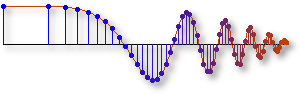Hint 2
- Find the amplitude.
- Find the period.
by measuring the time distance between peaks. - Calculate the frequency from the period.
- Find the phase.
by measuring the time of a peak.

I get \(0.25\) ms to the left, which is \(t_1 = -0.25\) ms.
What is the relationship between the phase angle, \(f\), and the time shift, \(t_1\)?
Recall that there are two ways of writing cosines, how do \(f\) and \(t_1\) relate?
\(A \cos(2 \pi f_0 t + f) = A \cos(2 \pi f_0 ( t-t_1 ))\)
Now we can equate the arguments of the two cosines: \(2 \pi f_0 t + f = 2 \pi f_0 ( t-t_1) \)
which leads to \(f=-2\pi f_0 t_1\)
Knowing the frequency and the time of the peak, you can calculate \(f\) now.
